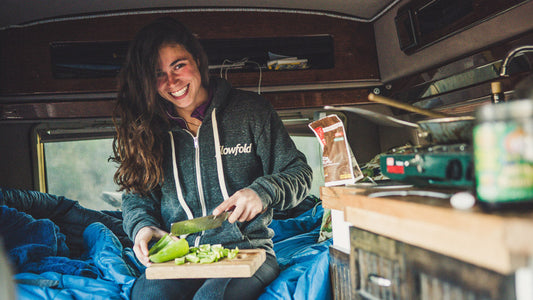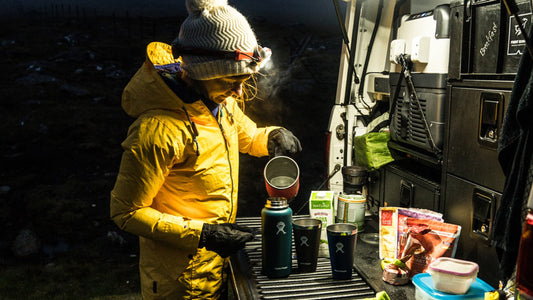Timmy O'Neill has ascended Yosemite National Park’s 3,000 foot El Capitan in just over two hours, and also spent nine days climbing and sleeping on the wall with his brother Sean, a t12 paraplegic. He is co-founder and former executive director of Paradox Sports, an NGO that helps integrate individuals with disabilities with outdoor recreation. O'Neill is a ten-year volunteer, ophthalmic tech, assisting in curing preventable blindness on the African continent. He is a 20-year climbing ambassador with Patagonia, Clif Bar and Osprey Packs. Timmy participated in the Feb, 2019 CureBlindness cataract intervention which partnered with South Sudan Medical Relief to provide 650 life-changing surgeries. He reached out to Good To-Go prior to traveling to South Sudan to see if we would be interested in working with him and Cureblindness.org to sponsor their efforts with meals for the doctors and other selfless individuals involved. Naturally, we offered whatever help was needed for this cause. Without further ado, here is his story.
Gatluak Gai has been blind for the last three of his 62 years and he’s walked four hours through the bush under a punishing sun led by his granddaughter to reach the clinic at Old Fangak in northern South Sudan. What I notice about him immediately, as he slowly moves his way up the line leading to surgery is the unlikely hat pulled fully onto his head, a fake-fur lined hunters cap complete with ear flaps and deep creases that match those of his face. Via an interpreter he told me that he learned of the high-volume cataract clinic via a short wave radio announcement and when I asked him what his expectations were he said, “My hope depends on God’s blessing.”
Faith often guides my actions, as my belief in the unknown has not only brought me to the tops of the world’s most inhospitable and towering rock formations but also to this very outreach to work again with Dr Geoff Tabin and his organization Cureblindness. The objective is baked into the name, to relieve the suffering caused by preventable blindness and, in particular, the blindness caused by cataracts. It is a disease of aging, that can also come early in life via trauma, so our potential patients span from great grandmother to great granddaughter. I’ve been a volunteer tech for the past decade working in sub-Saharan Africa with Dr Geoff and colleagues applying solutions that are based in medical science and powered by belief.

This place and population has suffered over twenty five years of civil unrest and there is an acute need for care. Following two decades of war for independence from Sudan we visited South Sudan twice, in 2011 and 2012, prior to the eruption of an internecine internal war spit on tribal lines. Our imminent 2013 campaign was thwarted and following an armistice in late 2018 we made the call to return. The infrastructure in the major cities is severely lacking and further afield it simply doesn’t exist. And due to major influxes of internally displaced persons as well as refugees from neighboring countries, the populace of Old Fangak originally 5,000 increased to over 65,000, adding further stress on an already maxed system.

Leading up to our departure we spoke with the indefatigable physician Dr Jill Seaman who has been providing medical care for almost two decades within Old Fangak in conjunction with her South Sudan Medical Relief (SSMR) program. We had visited her storied frontier clinic where she cares for the abandoned, dealing with diseases that either don't exist or have been eradicated in the developed world. We learned that even though the nutrition crisis was being solved and mass starvation staved off, there still may not be enough food to feed our international crew. Good To-Go solved that issue by providing their transportable, delicious and calorically significant packaged dehydrated meals. I loaded up two massive Osprey Packs roller bags with flavors of foods that spanned the globe, from Korean Bibimbap to Pad Thai to Mexican Quinoa Bowl to New England Corn Chowdah, plus ample dehydrated oatmeal and granola - amazing - and the best part was that when we arrived the other docs and techs working with SSMR knew and loved the food.


Our nine-person team from the US, Ethiopia and South Sudan consisted of three eye doctors, three surgical nurses, a biometrist to measure the eye and determine the new lens, an anesthetists and two techs. The word had spread via mouth and radio that doctors would be arriving to cure those with “white eyes” as the typical black pupil is obscured due to the milky occlusion of the defective intraocular lens. This news was beyond welcome, fore in a country of over 12 million, with only three eye surgeons all located in the capital Juba, the chance of any help arriving up until this point was zero.

We worked with Dr Jill’s amazing local staff as well which consisted of trained nurses, clinic managers and one of my favorites was 30-year old Sunday Phany, who was responsible for the paradoxical coal fired sterilization. He constantly wrapped and then pressure steamed the instrument trays filled with the micro tools that were used on over 600 patients in the five days we did surgery. I worked with him occasionally to assist in accelerating the process and he told me earnestly that “Mother,” his term of endearment for Dr JillI, “saved my life and I would do anything for her.” He explained the process of her nursing him back from the edge of certain death after he contracted tuberculosis in 2017 via a regimen of pills for over eight months; only one example of her selfless heroic work. We worked from dawn to dusk in twelve-hour days attending to a seemingly endless line of epic blindness. There’s virtually no care in the back of beyond so the theoretical knowledge of textbooks becomes the practical nightmares of examinations as the docs face patients dealing with pathologies they’ve only read about and never actually seen.

One late night while reading, after all were fast asleep, I answered a knock at the compound door to reveal Gotshalk, a tired and hunched clinician, softly petitioning for Dr Jill. She rose at the first call of her name and then walked across the quiet compound towards the canvas walled ward, where each bed is shrouded with a mosquito net. When she returned thirty minutes later, I was still awake and I quietly asked, “How was everything?” to which she replied, “One of our elderly patients who has been very ill was expected to die tonight and she did.” And with an audible exhalation punctuated by the words, “See you tomorrow” she turned in. Jill’s committed caregiving in this forgotten outpost made me understand that dignity is required as much for the dying as it is for the living.
Our cureblindness.org cataract interventions are filled with patients traveling long distances, often walking multiple days, spurred on by the possibility of being cured. This was the first eye health campaign in the region, and the largest ever in the country, and each morning we would walk outside the clinic compound and encounter masses of the newly arrived. There were often a child leading an elderly blind family member with the aid of mutually held staff. The beauty of these interventions is that you not only free the blind individual but also the ones caring for them. In the end we would depart knowing that we could always do more, as this was both the tip of the iceberg in regard to the need, and the tip of the spear as it pertained to trailblazing high-volume care.

The wish that Gatluak Gai prayed for came to fruition, as even though one of his eyes was hopelessly destroyed from the untreated ravages of infection, he only needed half the hope to see again, as Dr Geoff repaired him sufficiently to become that fabled one-eyed king, one with a virtually toothless smile that gleaned like diamonds. Although we may not provide the key to get into heaven, I believe we do provide the gateway out of hell. I penned a letter to my mom from the compound one night stating, “I often write you from the wild places where I engage in meaningful interaction and this is a prime example.” I always credit her for raising me to be an adventurous problem solver and to find the positive, “This place is filled with abject suffering and extreme deprivation…yet still it abounds with beauty, awe and love.”
Story and photos by Timmy O'Neill
Special thank you to the Cureblindness.org (Himalayan Cataract Project) staff for the providing this transformational procedure.
For more information on how you can help support their mission please visit Cureblindness.org
A $25 donation can literally restore sight by providing the material cost of one surgery. Your donation to the Himalayan Cataract Project delivers immediate life-changing eye care to poor and underserved populations that would otherwise go without care.





